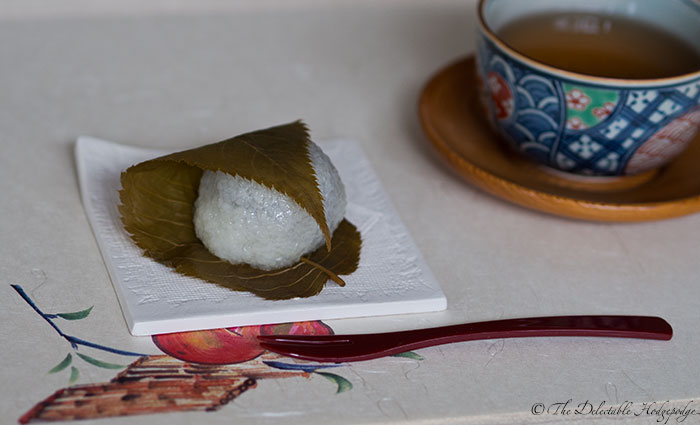
Kansai-Style Sakuramochi
| Ingredient | 10 Balls | 10 Balls |
|---|---|---|
| doumyouji-ko | 3½ oz | 100g |
| water | ¾ cup | 180 ml |
| sugar | 2 Tbsp. | 30g |
| koshian | 5-7 oz. | 150-200g |
| preserved sakura leaves | 10 leaves | 10 leaves |
| Syrup | ||
| water | 3 Tbsp. | 40 ml |
| sugar | 1½ Tbsp. | 20g |
This variation of sakuramochi hails from the western Kansai region of Japan, and apart from being based on a combination of sticky doumyouji-ko rice and fragrant sakura leaves, differs quite a bit from the identically named but crepe-like Kanto-style Sakuramochi. The Kansai version wraps a ball of sweet anko bean paste in a layer of sticky doumyouji-ko rice flour, the coarse-grained texture of which is quite a contrast to the soft, smooth mochiko coverings of many other Japanese confections. The salt-preserved leaf wrapper may look unappetizing to the unfamiliar, but they are tender and marvelously fragrant, and the mild saltiness contrasts perfectly with the sweet interior.
Taking a bite into one is an adventure of textures in miniature, layering the crisp leaf, sticky, chewy rice, and soft center. The wonderfully delicate combination of flavors and textures will bring a little bit of Japan’s famed springtime in the form of dessert to teatime or dessert regardless of how far away you might be in season and location.
Preparation
- Prepare one batch of koshian (or tsubuan, if you prefer).
- Divide the anko into 10 balls of equal size and set aside.
- Heat the water for the syrup and dissolve the sugar into it. You can either do this in a small pan on the stovetop, heating until the sugar completely dissolves, or in the microwave; combine the water and sugar in a small bowl and microwave until the sugar dissolves completely.
- Rinse the leaves then soak them in water for about 10 minutes. Blot dry with a paper towel.
Directions
- Prepare doumyoji-ko.
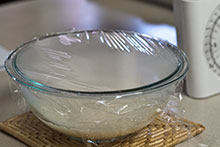 Put 140 ml (½ cup + 1 Tbsp.) of the water in a medium-sized microwavable bowl. Microwave on high for 50 seconds, or until boiling. Add doumyoji-ko, stir, cover the top of the bowl tightly with plastic wrap, and allow it to sit and steam for 10 minutes.
Put 140 ml (½ cup + 1 Tbsp.) of the water in a medium-sized microwavable bowl. Microwave on high for 50 seconds, or until boiling. Add doumyoji-ko, stir, cover the top of the bowl tightly with plastic wrap, and allow it to sit and steam for 10 minutes. - Add sugar and cook.
Add the sugar and remaining 40ml (¼ cup less 1 Tbsp.) of water to the bowl and stir until mixed. Cover lightly with plastic wrap and microwave on high for 3 minutes 30 seconds. - Vent bowl and let sit to steam.
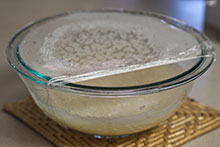 Peel back a bit of the plastic wrap to leave a small gap at the edge of the bowl; be careful not to burn yourself with escaping hot steam when you do this. Let sit for 10 minutes to steam.
Peel back a bit of the plastic wrap to leave a small gap at the edge of the bowl; be careful not to burn yourself with escaping hot steam when you do this. Let sit for 10 minutes to steam. - Stir.
Remove the wrap from the bowl and use a spatula or wooden spoon to fold the rice for a while to develop the texture. Wet the spatula with the syrup periodically to keep the rice from sticking to it. Fold with a gentle scooping motion from the bottom; if you smash the rice down it will break up the rice granules, which isn’t the goal.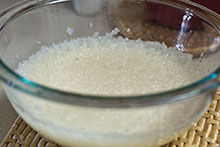
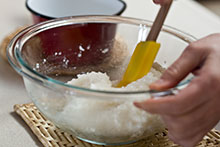
- Roll.
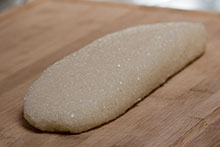 While the rice mixture is still hot, wet a smooth towel and wring out thoroughly, then turn the rice mixture out onto it. Wrap it in the towel and roll it into a longish cylinder. You can, alternately, use plastic wrap instead of a wet towel, but it will be quite hot working with it. Uncover the roll and use a knife or pastry scraper to cut it into 10 pieces of equal size.
While the rice mixture is still hot, wet a smooth towel and wring out thoroughly, then turn the rice mixture out onto it. Wrap it in the towel and roll it into a longish cylinder. You can, alternately, use plastic wrap instead of a wet towel, but it will be quite hot working with it. Uncover the roll and use a knife or pastry scraper to cut it into 10 pieces of equal size. - Form into disks.
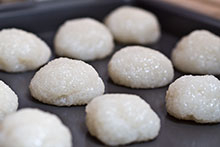 Wet your palms with the syrup to keep the rice from sticking to them. Roll the chunks of rice into balls between your hands, then squash them down and flatten them with your fingers into roughly 6cm (2½ inch) disks.
Wet your palms with the syrup to keep the rice from sticking to them. Roll the chunks of rice into balls between your hands, then squash them down and flatten them with your fingers into roughly 6cm (2½ inch) disks. - Cover anko balls with disks.
Put a disk of rice in one hand and push a ball of the anko lightly into the middle. Squeeze the edges up with your fingers and use your other hand to gently gather the rice together and stretch it until it completely covers the anko ball. Avoid getting anko on the outside of the ball, since it will look unsightly; if some gets on your fingers, wipe it off with the wet towel. Use your index finger and thumb to firmly pinch the seam together and seal the anko in. Repeat for remaining 9 balls. - Wrap in leaves.
Wash your hands but leave them wet. Roll each ball gently back and forth between your palms until it forms a slightly oblong barrel shape. Wrap each lightly with one of the leaves and serve at room temperature.
Notes
- Doumyouji-ko is a type of rice flour made from mochi rice that has been steamed, dried, and then broken into a coarse flour partway between rice and ground mochiko. Well-stocked Japanese specialty stores should carry it.
- Tsubuan can be used instead of koshian if you prefer it.
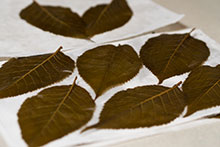 You should be able to find salt-preserved sakura leaves at Japanese specialty markets. It is also possible to make them yourself, if you have access to a tree.
You should be able to find salt-preserved sakura leaves at Japanese specialty markets. It is also possible to make them yourself, if you have access to a tree.- The finished sakuramochi can be stored, each tightly individually wrapped in plastic, in the freezer. Thaw at room temperature to eat.

